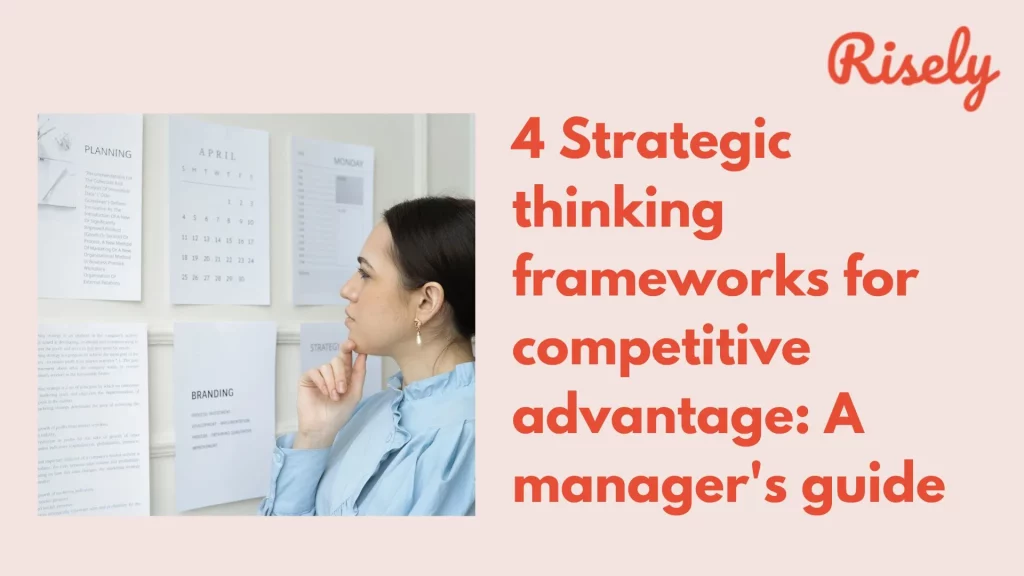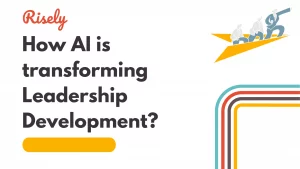As a manager, one of the most important skills you must possess is thinking strategically. Strategic thinking framework involves analyzing your team’s internal and external environment, setting goals and objectives, and monitoring performance. However, with so many different framework and models available, it can be overwhelming for managers to choose the best approach for their organization.
In this blog, we will explore various strategy thinking framework managers can use to develop a strategic plan and achieve their organization’s goals. In addition, we’ll discuss the advantages of each framework and provide practical tips on how to apply them in your organization. Whether you’re a seasoned manager or new to the role, this blog will provide valuable insights into strategic thinking and help you choose the best framework for your team and the organization.
What is a strategy thinking framework?
A strategy thinking framework is a systematic approach manager can use to develop and implement team strategies. This framework helps managers to think strategically, which involves analyzing the teams and organization’s internal and external environment, identifying key challenges and opportunities, and developing a course of action to address them.SWOT Analysis
SWOT analysis is a strategic planning tool to identify a team’s strengths, weaknesses, opportunities, and threats. It involves analyzing internal and external factors affecting a team’s performance, allowing managers to develop a strategy that considers them. The SWOT analysis is conducted by dividing the analysis into two parts: internal factors and external factors. Internal Factors: Strengths: These are the positive attributes of the team that give it an advantage over others. Weaknesses: These are the areas where the team needs improvement. External Factors: Opportunities: These external factors may positively impact the team’s performance. Threats: These external factors may negatively impact the organization’s performance. Once the SWOT analysis is complete, managers can use this information to develop a strategy that considers the team’s strengths and opportunities while mitigating weaknesses and threats.The advantages of using SWOT Analysis
- Provides a clear understanding of the team’s internal and external environment.
- It helps identify the team’s strengths, weaknesses, opportunities, and threats, allowing managers to develop a strategy that considers these factors.
- Enables managers to prioritize initiatives based on the organization’s strengths and opportunities and mitigate potential threats and weaknesses.
- Encourages collaboration among team members, allowing for a holistic view of the team.
- Allows managers to identify and respond to changes in the environment quickly.
Porter’s five forces
Porter’s Five Forces is a strategic thinking framework that helps managers understand the competitive dynamics of their industry. Developed by Michael Porter in 1979, the framework identifies five fundamental forces that shape the level of competition and profitability in an industry:- The threat of new entrants: The degree to which new competitors can enter the industry and threaten existing players.
- Bargaining power of suppliers: The degree to which suppliers can control the prices and quality of inputs.
- Bargaining power of buyers: The degree to which buyers can influence the prices and quality of outputs.
- The threat of substitutes: The degree to which alternative products or services can compete with existing offerings.
- Rivalry among existing competitors: The intensity of competition among existing players in the industry.
The advantages of using Porter’s five forces
- Provides a clear understanding of the industry’s competitive dynamics
- Identifies areas of opportunity
- Enables managers to prioritize initiatives
- Encourages collaboration
- Allows managers to identify and respond to changes quickly
Balanced Scorecard
The balanced scorecard is a strategic thinking framework that helps managers measure and manage their team’s performance. Developed by Robert Kaplan and David Norton in the 1990s, the framework emphasizes a balanced approach to performance measurement, considering financial metrics and non-financial metrics such as customer satisfaction, internal business processes, and learning and growth. The balanced scorecard framework consists of four perspectives:- Financial perspective: Measures the financial performance of the team, such as revenue, profit, and return on investment.
- Customer perspective: Measures customer satisfaction and loyalty, such as customer retention and market share.
- Internal business process perspective: Measures the efficiency and effectiveness of the organization’s internal processes, such as cycle time and defect rates.
- Learning and growth perspective: Measures the team’s ability to innovate and improve, such as employee training and development and investment in new technologies.
The advantages of using the Balanced Scorecard framework
- Provides a comprehensive view of performance: The balanced scorecard framework helps managers measure performance in multiple dimensions, including financial, internal processes, and learning and growth, providing a complete view of the team’s performance.
- Helps align strategy and initiatives: By developing strategic objectives and measures for each perspective, the balanced scorecard framework can help align resources and initiatives toward achieving those objectives.
- Enables managers to prioritize initiatives: By measuring performance from each perspective, managers can identify areas where improvement is needed and prioritize initiatives that address those areas.
- Allows managers to quickly identify and respond to changes: By regularly monitoring performance in each perspective, managers can quickly identify changes in the team’s environment and adjust their strategic plan accordingly.
Value Chain Analysis
Value chain analysis is a strategic tool that helps businesses understand their internal operations and identify areas for improvement. Michael Porter introduced the value chain concept in his book “Competitive Advantage: Creating and Sustaining Superior Performance.” The value chain is a series of activities a business performs to deliver a product or service to its customers. These activities can be divided into two categories: primary activities and support activities. Primary activities include inbound logistics, operations, outbound logistics, marketing and sales, and customer service. Support activities include procurement, technology development, human resource management, and infrastructure. Value chain analysis involves evaluating each activity in the value chain to determine how much value it adds to the final product or service. The analysis helps businesses identify areas to improve efficiency, reduce costs, and create a competitive advantage.The advantages of using Value Chain Analysis
- Increased efficiency: By identifying areas of the value chain where efficiency can be improved, managers can streamline operations, reduce waste, and save money.
- Cost reduction: Value Chain Analysis can help managers identify areas where costs can be reduced, such as process improvements, outsourcing, or automation.
- Innovation: Value Chain Analysis can help managers identify new opportunities for innovation by identifying areas where technology can improve operations.
- Customer focus: By understanding the value chain and how it impacts the final product or service, managers can focus on delivering value to customers.
Why do managers need to use a strategy thinking framework?
Managers need to use strategy thinking framework for the following reasons:- To analyze the business environment: Strategy thinking framework help managers analyze the internal and external environment of their team, including the market, competitors, and industry trends. This analysis helps managers identify opportunities and threats that can affect the business.
- To set goals and objectives: Strategy thinking framework help managers set clear goals and objectives for their teams based on a thorough understanding of the business environment.
- To develop strategies: Once goals and objectives are set, strategy thinking framework help managers develop effective strategies to achieve those goals. This involves identifying the best course of action and allocating resources accordingly.
- To monitor performance: Strategy thinking frameworks help managers monitor performance and track progress toward goals and objectives. This allows managers to make informed decisions and adjust strategies as necessary.
- To create a competitive advantage: By using strategy thinking frameworks, managers can identify areas where the team can create a competitive advantage, such as through innovation, cost reduction, or differentiation.
How to choose a strategic thinking framework?
Choosing a strategic thinking framework can be daunting for managers, as there are many different framework, each with its strengths and weaknesses. However, here are some key factors managers can consider when choosing a strategic thinking framework:- Organizational goals and objectives: Managers should choose a framework that aligns with the organization’s goals and objectives.
- Industry and market environment: The framework chosen should also be relevant to the industry and market environment in which the organization operates.
- The complexity of the organization: The complexity of the organization can also play a role in choosing a framework. A more detailed framework may be necessary if the organization is highly complex, with many departments and functions.
- Availability of resources: Some frameworks require significant resources, such as time, money, and personnel. Managers should consider the resources available to them when choosing a framework.
- Managerial expertise: When choosing a framework, managers should consider their expertise and experience. Some frameworks may require specialized knowledge or skills that the manager or team may not possess.
- Flexibility: Finally, managers should consider the flexibility of the framework. A too-rigid framework may not be adaptable to changing business environments or new opportunities.
Conclusion
In conclusion, strategy thinking frameworks are essential tools managers can use to develop a strategic plan and achieve long-term organizational success. From SWOT analysis to the Balanced scorecard, there are various frameworks to choose from, each with its strengths and weaknesses. Managers can choose the most effective framework for their team and organization by considering the organization’s goals, industry, market environment, complexity, resources, and managerial expertise. Furthermore, managers must remain open to adjusting or switching frameworks based on changes in the business environment or organizational priorities. Finally, with the right strategic thinking framework, managers can make informed decisions and guide their team and organization toward achieving its goals and objectives.Make smart decisions to bring your strategic insights to reality
Test your decision making skills for free with Risely’s free decision-making assessment for managers.
FAQs
What are the 5 key elements of a strategic framework?
– Vision
– Mission
– Goals and Objectives
– Strategies and Tactics
– Performance Metrics
– Mission
– Goals and Objectives
– Strategies and Tactics
– Performance Metrics
Why do managers need strategic thinking frameworks?
Managers need strategic thinking frameworks to help them make informed decisions that align with the team’s goals and objectives. These frameworks provide
– a systematic approach to identifying and prioritizing opportunities and risks,
– maximizing the use of resources, and
– creating a shared understanding and commitment to the organization’s mission and vision.
– a systematic approach to identifying and prioritizing opportunities and risks,
– maximizing the use of resources, and
– creating a shared understanding and commitment to the organization’s mission and vision.
What is the difference between a framework and a strategy?
A framework is a structured approach or methodology guiding an approach to a particular problem. It is a model that helps organize information and ideas to make them more understandable and manageable. On the other hand, a strategy is a plan or course of action that is designed to achieve a specific goal or objective. It is a plan for allocating resources and deciding to achieve a desired outcome.
What are the three pillars of strategic thinking?
The three pillars of strategic thinking are Foresight, Insight, and Cross-functional thinking.






